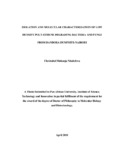| dc.description.abstract | Dandora dumpsite is Nairobi's official main dumpsite and is close to the city‘s informal settlements. This study aimed at isolating and identifying bacteria and fungi with the capacity to degrade low density poly-ethene (LDPE) from the dumpsite. The level of biodegradation of LDPE sheets with bacterial and fungal inoculums from different sampling points was evaluated under laboratory conditions of 37˚C and 28˚C for bacteria and fungi respectively for sixteen weeks in a shaker incubator. Thirty bacterial isolates and 26 fungal isolates were isolated based on biodegradation outcomes. Twenty bacterial isolates and 10 fungal isolates were identified using 16S rDNA and 18S rDNA sequences for bacteria and fungi respectively. Bacteria of genus Pseudomonas, Bacillus, Brevibacillus, Cellulosimicrobium, Lysinibacillus and fungi of genus Aspergillus were implicated as poly-ethene degraders. The extent of biodegradation on the poly-ethene sheets was assessed by weight loss analysis, Fourier Transform Infrared Spectroscopy (FTIR) and GC-MS. The spectral analysis of the FTIR outcomes revealed appearance of aldehydes, ether and carboxyl functional groups on the poly-ethene sheets while GC-MS outcome indicated presence of a ketone which is an intermediary product in the culture media. An overall analysis confirmed that fungi are generally better degraders of polyethene than bacteria. The highest fungal degradation activity yielded a mean weight loss of 36.4±5.53 % attributed to Aspergillus oryzae strain A5, 1 (MG779508) while the highest degradation activity for bacteria had a mean of 35.72±4.01% and 20.28±2.30% attributed to Bacillus cereus strain A5,a (MG645264) and Brevibacillus borstelensis strain B2,2 (MG645267) respectively. The isolates were screened for their ability to produce extra cellular enzymes and the fungal isolates Aspergillus fumigatus strain B2,2 (MG779513) and Aspergillus oryzae strain A5,1-(MG779508) were confirmed to produce the highest laccase activity and esterase activity respectively. Investigation for the presence of genes that are responsible for the production of alkane degrading enzymes was done and the primer set Alkb1 was able to amplify the fragment of size 870 bp in 4 bacterial and 18 fungal samples. Presence of this gene in LDPE degrading bacteria and fungi is an indication of the inherent ability of these microorganisms to take
xv
part in the bioremediation process since alkanes are major constituent of LDPEs. The optimum growth of the bacterial isolates at 600nm was found to be a temperature of between 30-40˚C, pH 6-8 and sodium chloride concentration of 0 while fungal optimum growth was at: temperature 30˚C, pH 8 and sodium chloride concentration of 0. From this study, it is notable that fungi and bacteria capable of degrading LDPE can be isolated from dumping sites of these materials and that Aspergillus oryzae strain A5, 1 and Bacillus cereus strain A5,a can be used in the bioremediation of poly-ethene from the environment. The possession of AlkB 1 gene for production of alkane degrading hydroxylase confirms the molecular basis for their LDPE degrading capacity which is further supported by their ability to produce enzymes implicated in this process. These, coupled with the right growth conditions may serve to better utilize microbes in the bioremediation of LDPE. We recommend further optimization of culture conditions for optimum activity of microbes that show potential of degradation especially where coculturing is involved. Region wise bio prospecting for LDPE biodegrading microorganisms could lead to discovery of more and better degraders which may enable this kind of bio remediation to be done on a larger scale. Further, the knowledge of genes present in the identified microorganisms responsible for producing different polymer degrading enzymes will inform the use of the right microbial consortia in bio degradation processes. The use of recombinant DNA technology to insert genes that produce LDPE degrading enzymes into good degraders will serve to further improve their degrading potential. | en_US |

